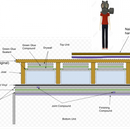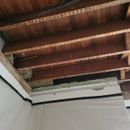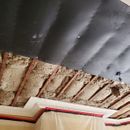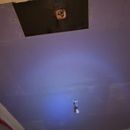Detailing a Vapor Retarder
Hi folks,
I Hope everyone is doing well. I am looking for insight, feedback on the following situation.
context: old Victorian, 2 floors, single family home converted (long time ago) into 2 units condo. No work was done to insulate top and bottom at the time.
Recently did sound proofing work and packed the space between top and bottom units with lots of stuff (see diagram).
No vapor barrier was installed. Now, all materials are off-gassing into top floor unit through old subfloor (lots of gaps between planks). Causing air quality issues (burning nose, throat). VOC Fest for the last year with no sign of subsiding.
Failed Mitigation: 3 coats of AFM SafeCoat, Polyureseal BP on top of subfloor + silicon gel around baseboards. Seal didn’t do well around wood filled area and because of the old floor flexing.
Last resort: Sheet of 6 mil poly vapor barrier on top of old subfloor + taped at edges and overlap + new 5/16 nailed down finished floor on top.
Some questions:
– what US available tape for taping vapor barrier?
– closing up inner space ok from a moisture standpoint?
– What class of vapor barrier in such context?
What are your thoughts?
GBA Detail Library
A collection of one thousand construction details organized by climate and house part














Replies
First, FumedOut, I feel for you--what an awful situation to be facing. Second,
I recommend reading these two articles while you wait for field experts to weigh in:
Vapor Retarders and Vapor Barriers and
Do I need a Vapor Retarder?. They address the class and moisture concern aspects of your situation.
Thank you for those articles Kiley.
The challenges is that the scenarios described are exterior/interior Vs. in my case interior/inner space/interior. Hard for me to extrapolate with my limited knowledge.
It does raise the question of the need for an air barrier Vs. a vapor barrier, since my goal is to prevent off gassing from the components below (Roxul Safe N Sound, SilentFX Drywall and a ton of "Green Glue" compound and sealant).
Now since the floor has been exposed to inside air, and it was summer in San Francisco (Zone 3, Fog Fest, ~60% Humidity inside, ) it is likely that Some moisture got into the subfloor and in the drywall under the subfloor. Now if I lock it under a barrier, what happens?
For reference:
https://www.rockwool.com/north-america/products-and-applications/products/safensound
https://www.certainteed.com/drywall/products/silentfx-quickcut-drywall/
https://www.greengluecompany.com/products/noiseproofing-compound
You did a lot of things right with your soundproofing there except for the MLV. That is doing practically nothing for sound and most likely the source of your VOCs. I've used the rest of the stuff in there (drywall, green glue compound, green glue sealant) without issues in many applications, no problems with VOCs at all.
Eventually the MLV will stop off gassing, when that will be is hard to tell.
I doubt you'll ever seal the floor well enough to stop the smell coming through. The best solution is to demo the ceiling and get rid of the MLV. The other option is to add an air exchanger and improve the ventilation to the upper unit. Installing an ERV or HRV with stale air pickups near floor level should go a long way in controlling the smell.
> materials are off-gassing into top floor
Keeping the unoccupied units excessively warm and/or adding some ozone will drive off odors faster.
If "going away" isn't viable, think "how can I change pressure to effect polluted airflow?". For example, you could put dimple mat on the floor and depressurize the gap. Or slightly pressurize the upper floor.